VMFA-251
| Marine Fighter Attack Squadron 251 | |
|---|---|
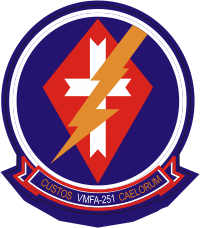 | |
| Active |
|
| Country | F/A-18A/C Hornet |
Marine Fighter Attack Squadron 251 (VMFA-251) was a United States Marine Corps F/A-18 Hornet squadron. Known as the "Thunderbolts", the squadron was deactivated on 23 April 2020. If current plans hold, the squadron is to be re-activated by 2025 as a F-35C Lightning II and based at Marine Corps Air Station Cherry Point, North Carolina.
History
World War II
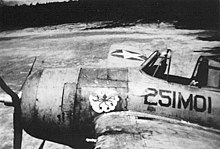
Marine Observation Squadron 251 (VMO-251) was commissioned 1 December 1941 at


In 1943, the squadron transitioned to the
On 1 June 1945, VMF-251 was deactivated at Samar, Philippines Island. Thirteen months later on 1 July 1946, VMF-251 was reactivated at Grosse Ile, Michigan as a ready-reserve squadron.[citation needed]
Korean War

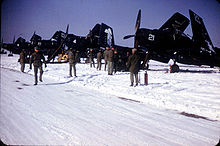
With the outbreak of the
In January 1956, the Black Patches relocated to
In April 1958 VMF-251 was moved to
Cold War
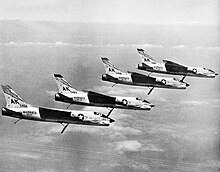
In 1961, VMF-251 was assigned to Marine Aircraft Group 31 (MAG-31) at Marine Corps Air Station Beaufort, South Carolina. In August and September 1961 the squadron was deployed to Guantanamo Bay, Cuba and to Jamaica during the time between the Bay of Pigs Invasion and the Cuban Missile Crisis. From February through August 1962, VMF-251 was the first Marine F-8 squadron to deploy on board an aircraft carrier as part of Carrier Air Group Ten on the USS Shangri-La (CVA-38). During the cruise, VMF-251 set the record for the most flight time in one month for a Sixth Fleet based F-8 squadron by flying over 500 hours. In July 1963 the Thunderbolts were the recipients of the 2nd MAW Commanding General's award for achievement in competitive exercises which took place while the squadron was deployed to NAS Roosevelt Roads, Puerto Rico.
On 31 October 1964, the Thunderbolts became the first Marine squadron in
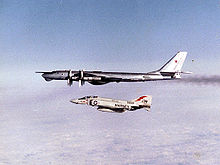
In September 1980 the Thunderbolts deployed to
After twenty-one years and 85,000 flight hours, VMFA-251 flew its last F-4S Phantom in November 1985. In January of the following year, the Thunderbolts transitioned to the
The 1990s
The squadron transitioned from the aging F/A-18A to the
From January to April 1994, the Thunderbolts flew
Global War on Terror

On 12 February 2003, the squadron deployed to Ahmed Al Jaber Airbase,
In 2006 the squadron deployed to
Unit Awards
- Bronze Star
(19 Aug 1942 – 9 Dec 1942)
(21 Mar 2003 – 24 Apr 2004)  Navy Unit Commendation Streamer with two Bronze Stars
Navy Unit Commendation Streamer with two Bronze Stars
(7 Jul 1953 – 27 Jul 1953)
(1 Oct 1997 – 30 Apr 1998)
(11 Sep 2001 – 3 Mar 2002) Meritorious Unit Commendation Streamer with four Bronze Stars
Meritorious Unit Commendation Streamer with four Bronze Stars
(1 Aug 1983 – 31 Mar 1986)
(1 Aug 1987 – 1 Jul 1989)
(25 Aug 1995 – 24 Feb 1996)
(31 Oct 1999 – 31 Mar 2000)
(1 Sep 2001 – 1 Aug 2004) Marine Corps Expeditionary Streamer
Marine Corps Expeditionary Streamer
(Cuba, Aug 1961 – Sep 1961) American Defense Service Streamer
American Defense Service Streamer
(1 Dec 1941 – 7 Dec 1941) American Campaign Streamer with one Bronze Star
American Campaign Streamer with one Bronze Star
(7 Dec 1941 – 18 Jun 1942)
(31 May 1943 – 29 Feb 1944)- Silver Starand one Bronze Star
(Capture and Defense of Guadalcanal, 19 Aug 1942 – 8 Feb 1943)
(Consolidation of the Southern Solomons, 9 Feb 1943 – 11 May 1943)
(Santa Crux, 26 Oct 1943)
(Consolidation of the Northern Solomons, 18 Jun 1944 – 30 Dec 1944)
(Luzon Operation, 3 Jan 1945 – 1 April 1945)
(Southern Philippines, 2 April 1945 – 1 May 1945)  World War II Victory Streamer
World War II Victory Streamer
(7 Dec 1941 – 1 Jun 1945) National Defense Service Streamer with three Bronze Stars
National Defense Service Streamer with three Bronze Stars
(27 Jun 1950 – 27 Jul 1954)
(1 Jan 1961 – 14 Aug 1974)
(2 Aug 1990 – 30 Nov 1995)
(11 Sep 2001 – TBD) Korean Service Streamer with one Bronze Star
Korean Service Streamer with one Bronze Star
(Korea, Summer Fall 1953, 5-27 July 1953) Armed Forces Expeditionary Medal Streamer
Armed Forces Expeditionary Medal Streamer
(Operation Southern Watch, 20 Feb 2003 – 18 Mar 2003) Southwest Asia Service Medal Streamer
Southwest Asia Service Medal Streamer
(Operation Southern Watch, Nov 1995 - Nov 1995) Afghanistan Campaign Medal Streamer
Afghanistan Campaign Medal Streamer
(Operation Enduring Freedom, Jul 2007 - Dec 2007) Iraq Campaign Medal Streamer
Iraq Campaign Medal Streamer
(Operation Iraqi Freedom, 2006 - 2006) Global War on Terrorism Expeditionary Medal Streamer
Global War on Terrorism Expeditionary Medal Streamer
(Operation Enduring Freedom, 11 Sep 2001 – Mar 2002) Global War on Terrorism Service Medal Streamer
Global War on Terrorism Service Medal Streamer
(Operation Enduring Freedom, 11 Sep 2001 – Mar 2002)
(Operation Iraqi Freedom, 20 Mar 2003–2003)- Philippine Presidential Unit Citation Streamer
(2 Jan 1945 – 1 Jun 1945)  Philippine Liberation Streamer with one Bronze Star
Philippine Liberation Streamer with one Bronze Star
(2 Jan 1945 – 2 Jun 1945)
(2 Jan 1945 – 1 May 1945)
See also
- List of active United States Marine Corps aircraft squadrons
- United States Marine Corps Aviation
- List of decommissioned United States Marine Corps aircraft squadrons
Citations
 This article incorporates public domain material from websites or documents of the United States Marine Corps.
This article incorporates public domain material from websites or documents of the United States Marine Corps.
- ^ "Marine Observation Squadron (VMO-251) History". MCARA Units. Retrieved 25 November 2010.
- ^ Tillman (1979), p.90.
- ^ Maj Boggs, Charles W. "Marine Aviation in the Philippines". Retrieved 17 December 2007.
- ^ "United States Marine Corps Muster Rolls - 1949-1953" (PDF). NARA. United States Marine Corps. p. 24. Retrieved 23 November 2023.
- ^ Flemming, Nikki (October 12, 2006). "Thunderbolts add to their rich history". Marine Corps News. U.S. Marine Corps. Archived from the original on August 17, 2008. Retrieved April 12, 2008.
- ^ Arkin, William M. (September 1987). "Navy autonomy thwarts arms control". Bulletin of the Atomic Scientists, Vol. 43, No. 7. Retrieved 25 November 2010.
- ^ "Commandant, Marine Corps sergeant major visit Thunderbolts at Al Asad". Marine Corps News. U.S. Marine Corps.
- ^ "VMFA-251, VFA-86 to return to Beaufort Sunday". 14 December 2007. Retrieved 14 December 2007.
- ^ Cpl Mecure, James M. (21 December 2007). "Thunderbolts, Sidewinders return from 6-month deployment". Archived from the original on 4 March 2008. Retrieved 21 December 2007.
References
- Bibliography
- Crowder, Michael J. (2000). United States Marine Corps Aviation Squadron Lineage, Insignia & History - Volume One - The Fighter Squadrons. Turner Publishing Company. ISBN 1-56311-926-9.
- Rottman, Gordon L. (2002). U.S. Marine Corps World War II Order of Battle - Ground and Air Units in the Pacific War, 1939 - 1945. Greenwood Press. ISBN 0-313-31906-5.
- Sherrod, Robert (1952). History of Marine Corps Aviation in World War II. Washington, D.C.: Combat Forces Press.
- Tillman, Barrett. Corsair: The F4U in World War II and Korea. Annapolis, Maryland: Naval Institute Press, 1979. ISBN 1-55750-994-8.
- Dixon, Steven K. Photo Recon Became Fighter Duty: Marine Observation Squadron 251 in World War II. Jefferson, North Carolina: McFarland & Company, Inc., 2016. ISBN 978-0-7864-9798-0.
- Web


